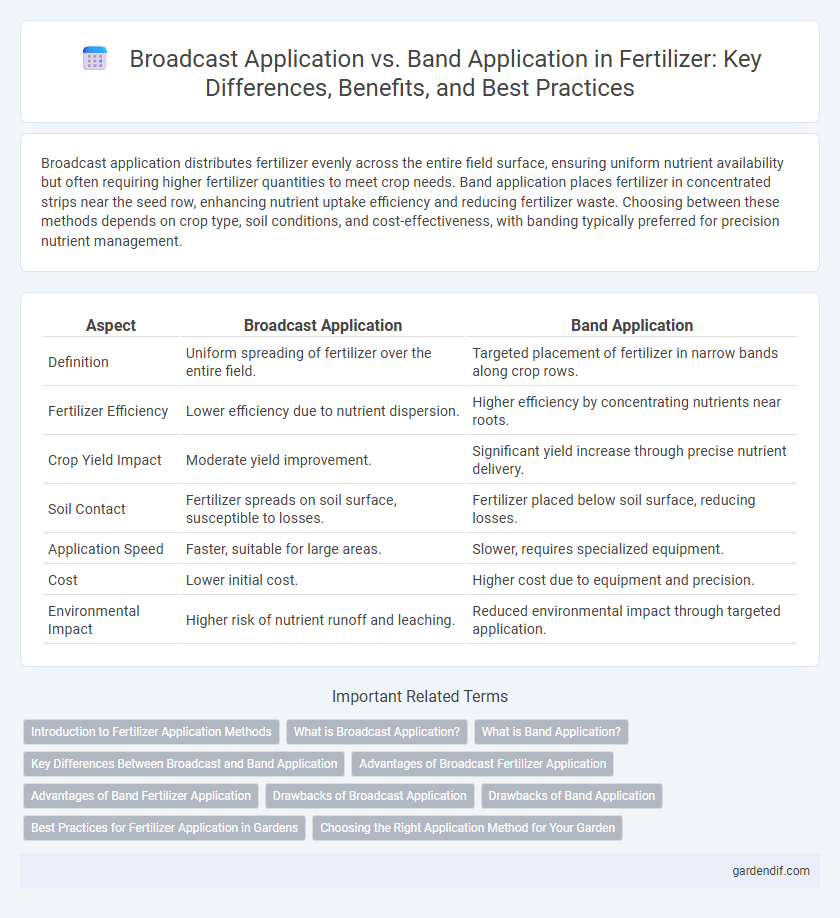
Broadcast application vs Band application Illustration
Broadcast application distributes fertilizer evenly across the entire field surface, ensuring uniform nutrient availability but often requiring higher fertilizer quantities to meet crop needs. Band application places fertilizer in concentrated strips near the seed row, enhancing nutrient uptake efficiency and reducing fertilizer waste. Choosing between these methods depends on crop type, soil conditions, and cost-effectiveness, with banding typically preferred for precision nutrient management.
Table of Comparison
| Aspect | Broadcast Application | Band Application |
|---|---|---|
| Definition | Uniform spreading of fertilizer over the entire field. | Targeted placement of fertilizer in narrow bands along crop rows. |
| Fertilizer Efficiency | Lower efficiency due to nutrient dispersion. | Higher efficiency by concentrating nutrients near roots. |
| Crop Yield Impact | Moderate yield improvement. | Significant yield increase through precise nutrient delivery. |
| Soil Contact | Fertilizer spreads on soil surface, susceptible to losses. | Fertilizer placed below soil surface, reducing losses. |
| Application Speed | Faster, suitable for large areas. | Slower, requires specialized equipment. |
| Cost | Lower initial cost. | Higher cost due to equipment and precision. |
| Environmental Impact | Higher risk of nutrient runoff and leaching. | Reduced environmental impact through targeted application. |
Introduction to Fertilizer Application Methods
Broadcast application disperses fertilizer evenly across the soil surface, enhancing nutrient availability for a wide range of crops and promoting uniform growth. Band application places fertilizer in concentrated strips near the seed row, improving nutrient uptake efficiency and reducing fertilizer waste. Selecting the appropriate method depends on crop type, soil conditions, and nutrient management goals to optimize yield and minimize environmental impact.
What is Broadcast Application?
Broadcast application refers to the method of spreading fertilizer evenly across the entire soil surface without targeting specific plants or rows. This technique is commonly used for applying nutrients quickly over large areas, improving soil fertility uniformly. It is particularly effective for crops that benefit from widespread nutrient distribution, such as cereals and forage grasses.
What is Band Application?
Band application involves applying fertilizer in a concentrated strip or narrow band directly alongside the seed row, enhancing nutrient availability to young plants. This method reduces fertilizer contact with soil surfaces exposed to runoff or volatilization, improving nutrient use efficiency and minimizing environmental loss. Compared to broadcast application, banding delivers nutrients precisely where roots can access them early, promoting healthier crop establishment and yield.
Key Differences Between Broadcast and Band Application
Broadcast application disperses fertilizer uniformly over the entire soil surface, promoting widespread nutrient availability, while band application places fertilizer in concentrated strips near the seed row, optimizing nutrient uptake efficiency. Broadcast methods typically require higher fertilizer rates due to potential nutrient loss, whereas band application reduces fertilizer use by targeting root zones directly, enhancing nutrient use efficiency and minimizing environmental impact. Band application is especially effective in row crops for precise nutrient placement, whereas broadcast suits crops with dense canopies or where uniform fertilization is critical.
Advantages of Broadcast Fertilizer Application
Broadcast fertilizer application offers the advantage of uniform nutrient distribution across the entire soil surface, promoting consistent crop growth and reducing nutrient hotspots. This method simplifies the application process, enabling faster coverage over large areas with less labor intensity compared to band application. Enhanced soil nutrient availability in the root zone through broadcasting supports improved plant uptake and overall yield potential.
Advantages of Band Fertilizer Application
Band fertilizer application delivers nutrients directly to the root zone, enhancing nutrient use efficiency and reducing fertilizer runoff compared to broadcast application. This targeted approach promotes stronger plant growth by supplying concentrated nutrients where they are most accessible. Reduced fertilizer usage through banding also minimizes environmental impact and lowers input costs for farmers.
Drawbacks of Broadcast Application
Broadcast fertilizer application often results in uneven nutrient distribution, leading to potential nutrient runoff and environmental pollution. This method can cause higher fertilizer wastage due to exposure on soil surfaces, reducing overall efficiency. Additionally, broadcast application may promote weed growth by spreading nutrients over unwanted areas, complicating crop management.
Drawbacks of Band Application
Band application of fertilizer can lead to uneven nutrient distribution, resulting in localized high concentrations that may cause root burn and reduced plant growth. It often requires precise placement equipment, increasing operational complexity and cost compared to broadcast application. Limited nutrient availability to the entire root zone in banding may reduce overall crop uptake efficiency and yield potential.
Best Practices for Fertilizer Application in Gardens
Broadcast application evenly distributes fertilizer across the entire garden surface, promoting uniform nutrient availability and quick soil absorption. Band application places fertilizer in concentrated strips close to plant roots, enhancing nutrient uptake efficiency and reducing runoff risks. Best practices recommend selecting broadcast for widespread coverage and banding for targeted feeding, especially in nutrient-sensitive or small garden areas.
Choosing the Right Application Method for Your Garden
Selecting the ideal fertilizer application method depends on soil type, crop needs, and garden size, with broadcast application dispersing nutrients evenly across the surface and band application placing fertilizers in concentrated strips near plant roots. Broadcast methods enhance coverage for large areas, while band applications improve nutrient use efficiency and reduce fertilizer loss, particularly in row crops or high-value gardens. Understanding plant nutrient uptake and local environmental conditions ensures optimal growth and resource management with the chosen technique.
Broadcast application vs Band application Infographic

 gardendif.com
gardendif.com